Rheinmetall-Borsig MK 108 30mm cannon Luft '46 entry (original) (raw)
Rheinmetall-Borsig MK 108 30mm cannon
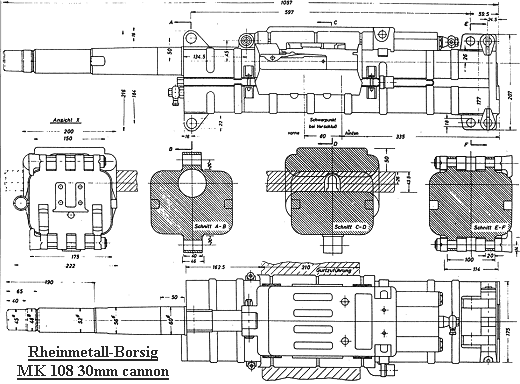 In many ways, the Rheinmetall-Borsig MK 108 30mm cannon was considered to be a masterpiece of weapons engineering, due to it's compact size, ease of manufacture and hitting power. Although it was first designed by Rheinmetall-Borsig in 1940 as a private venture, the design was finalized in 1942. It met a later RLM requirement for a new aircraft cannon that could knock down enemy bombers with the lowest expenditure of ammunition and stay beyond the range of enemy defensive fire.
In many ways, the Rheinmetall-Borsig MK 108 30mm cannon was considered to be a masterpiece of weapons engineering, due to it's compact size, ease of manufacture and hitting power. Although it was first designed by Rheinmetall-Borsig in 1940 as a private venture, the design was finalized in 1942. It met a later RLM requirement for a new aircraft cannon that could knock down enemy bombers with the lowest expenditure of ammunition and stay beyond the range of enemy defensive fire.
In short, the MK 108 was a blow-back operated, rear-seared, belt fed 30 mm cannon using electric ignition and was charged and triggered by simple compressed air. One drawback was that once installed, there was no method to adjust the gun's harmonization. One distinctive physical feature was the very short gun barrel, which gave the MK 108 a low muzzle velocity of 500-540 meters (1640-1770 feet) per second. The maximum rate of fire was 650 rounds per minute. The operating sequence for the MK 108 went like this:
- An ammunition can fed the rounds to the gun by means of a disintegrating belt
- Once the sear was released, the bolt went forward under the action of the two driving springs
- A projection on the top of the bolt passed through the ring, thus extracting a round
- This then forced the round into the chamber and fired the round while the heavy bolt was still moving forwards
- The empty cartridge case reinserted itself in its link after firing
- Ejection was achieved by means of pawls activated by camming grooves that were cut into the top of the bolt
- Finally, the new round slipped into position and the sequence repeated
An interesting feature was that neither the barrel or receiver moved in recoil, the entire force of firing was absorbed by the rearward movement of the bolt against the driving springs, which buffered against the recoil. No locking mechanism was needed, because by the time the fired round had overcome the inertia of the firing bolt, the round had left the barrel and the pressure had dropped.
There were two main types of ammunition for the MK 108 to use, a 30 mm high-explosive self-destroying tracer ("M-Shell" or "Mine-Shell") and a 30 mm incendiary shell. The first type was designed to cause a maximum blast effect by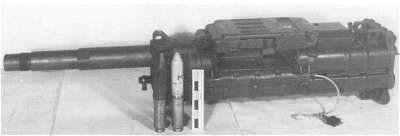 combining a very thin shell casing with the maximum load of explosive. Tests carried out at Rechlin (where most of the Luftwaffe aircraft and weapons tests were done) showed that with a "M-Shell" with 85 grains of explosive, five hits could destroy a B-17 or B-24 bomber. The second type of shell, the incendiary, was meant to be targeted at the fuel tanks of the enemy plane. Since some penetrating force was still needed to overcome the armor or airframe of the target, and not have the shell break up or explode upon contact, a hydrodynamic fuse was fitted so that the shell only exploded once it came into contact with liquid.
combining a very thin shell casing with the maximum load of explosive. Tests carried out at Rechlin (where most of the Luftwaffe aircraft and weapons tests were done) showed that with a "M-Shell" with 85 grains of explosive, five hits could destroy a B-17 or B-24 bomber. The second type of shell, the incendiary, was meant to be targeted at the fuel tanks of the enemy plane. Since some penetrating force was still needed to overcome the armor or airframe of the target, and not have the shell break up or explode upon contact, a hydrodynamic fuse was fitted so that the shell only exploded once it came into contact with liquid.
Although there were drawbacks with the MK 108, such as an insufficient flat trajectory (the shell "arced" too much due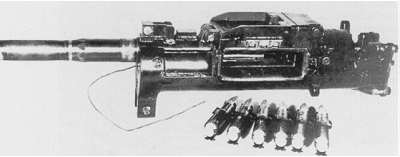 to the low muzzle velocity) and that the ammunition belts sometimes ripped when the guns were fired while the aircraft was banking sharply, the MK 108 was chosen to be fitted in a wide variety of Luftwaffe aircraft (please see table below) before the war's end. It was also planned to be used in many of the project aircraft also (please see table below), for the reasons given above: ease of manufacture, compact size and weight and destructive power. The MK 108 30mm cannon earned a fearsome reputation among Allied bomber crews, who named it the "pneumatic hammer" due to its distinctive firing sound.
to the low muzzle velocity) and that the ammunition belts sometimes ripped when the guns were fired while the aircraft was banking sharply, the MK 108 was chosen to be fitted in a wide variety of Luftwaffe aircraft (please see table below) before the war's end. It was also planned to be used in many of the project aircraft also (please see table below), for the reasons given above: ease of manufacture, compact size and weight and destructive power. The MK 108 30mm cannon earned a fearsome reputation among Allied bomber crews, who named it the "pneumatic hammer" due to its distinctive firing sound.
Rheinmetall-Borsig MK 108 30mm cannon data
| Designation | Maunfacturer | Caliber | Length | Weight | Rounds/ Minute | Muzzle Velocity | Projectile Weight | Cartridge Weight |
|---|---|---|---|---|---|---|---|---|
| MK 108 | Rheinmetall-Borsig | 30 mm1.18" | 1057 mm3' 5.6" | 58 kg127.9 lbs | 660* | 500-540 m1640-1770' | 330 g0.73 lbs | 480 g1.05 lbs |
* The rate of fire was to be improved to 850 rounds/minute later
Cutaway Schematic of the MK 108 Firing Operation
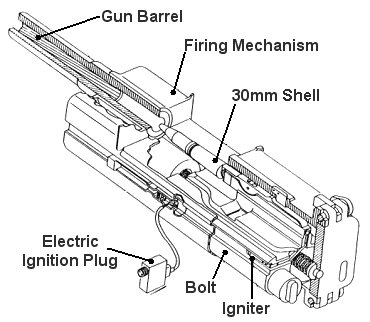 |
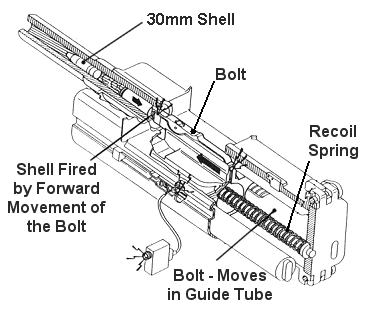 |
|---|
Please click here for a large format drawing of the Rheinmetall-Borsig MK 108 30mm cannon
(opens in a new browser window)
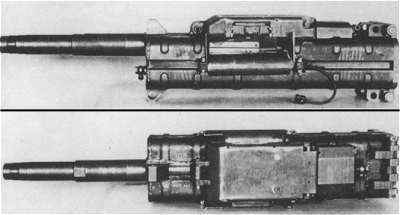
The Rheinmetall-Borsig
MK 108 30mm cannon
|��������� 1057 mm (3' 5.6") ��������|
Although not a high quality photo, the small size of the MK 108 is apparent (note hands on left)
| Luftwaffe Aircraft that used the MK 108 Aircraft Number Location Notes Bv 155 1 engine prototype flown Bv 40 2 wing roots glider - 6 examples built Fw 190 2 wings various 190 variants Ta 152 1 engine C and H models Ta 154 2 fuselage He 219 2 wing roots 2 additional firing upwards Ho 229 4 wing prototype flown He 162 2 fuselage later replaced with Mg 151 Ju 388 2 ventral bulge J-1 night fighter version Bf 109 1 or 2 engine orunder wing various models fromG onwards Bf 110 2 cockpit firing upwards Me 163 2 wing roots Me 209 1 engine never entered service Me 262 4 nose standard armament Me 410 2 nose B-2/U2/R2 version | Projects Planned for use with the MK 108 Project Number Notes Ar E.581 1 parasite fighter Ar Projekt II 4 jet night fighter Bv P.207.03 4 pusher prop fighter Bv P.208.03 3 tailless pusher prop fighter Bv P.212 up to 7 tailless jet fighter Bv P.215 up to 5 tailless jet night fighter Do P.247 3 pusher prop fighter Fw Ta 183 4 swept wing jet fighter Fw J.P.011-45 4 jet night fighter Fw "Flitzer" 2 jet fighter - mock up built Go P.60A 4 flying wing jet fighter He P.1077 "Julia" 2 unpowered protypes built He P.1078B 2 "twin nose" jet fighter He P.1079A 4 twin jet night fighter He "Lerche" 2 VTOL fighter Hs P.135 4 jet fighter Ju EF128 2 tailless jet fighter Li P.20 2 tailless jet fighter Me 609 up to 4 twin fuselage fighter Me P.1099A up to 4 twin jet heavy fighter Me P.1101 4 prototype 90% complete SK P.14.01 1 ramjet fighter |
|---|
Note: Neither list above encompasses all the actual aircraft or aircraft projects that used the Mk 108 30mm cannon